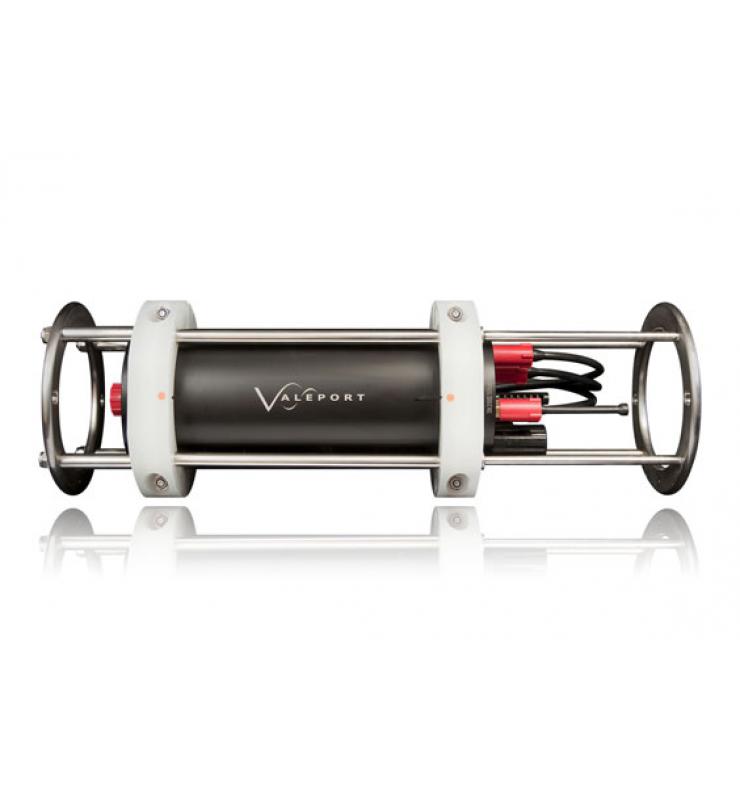Valeport applies its unique distributed processing technology to the MIDAS CTD+, resulting in a multiparameter CTD that is essentially tailor made to suit each customer’s requirements. The instrument is able to accept any combination of a range of industry standard sensors, giving calibrated data in both autonomous and real time operations. A choice of titanium or acetal construction makes it suitable for coastal or deep water operations, and the intuitive software allows a range of both simple and complex sampling regimes.
Sensors
The MIDAS CTD+ is fitted with CTD sensors as standard, plus your choice of optional additional sensors, either remote or bulkhead mounted. The CTD+ can also operate with Valeport’s water sampler system, described on a separate brochure.
Conductivity
Type: Inductive Cell
Range: 0-80mS/cm
Accuracy: ±0.01mS/cm
Resolution: 0.002mS/cm
Pressure
Type: Piezo-Resistive
Range: Up to 600Bar
Accuracy: ±0.01%
Resolution: 0.001%
Temperature
Type: PRT
Range: -5-35℃
Accuracy: ±0.005℃
Resolution: 0.002℃
Turbidity
Type: Seapoint STM
Range: 0-2000FTU
Accuracy: ±2%
Resolution: 0.002%
DO
Type: Clark Cell
Range: 0-16ml/l
Accuracy: ±0.07ml/l
Resolution: 0.017ml/l
PH
Type: Electrode
Range: 1-13
Accuracy: ±0.05
Resolution: 0.01
Redox
Type: Electrode
Range: ±1500mV
Accuracy: ±1mV
Resolution: 0.1mV
Chlorophyll
Type: Fluorometer
Range: 0-150μg/l
Accuracy: ±0.03μg/l
Resolution: 0.005%
PAR
Type: LICOR
Range: 10,000μmol/s/m2
Accuracy: ±1%
Resolution: 0.5μmol/s/m2
Other sensors are also available – please consult Valeport
Data Acquisition
The MIDAS CTD+ uses the concept of distributed processing, where each sensor has its own microprocessor controlling sampling and calibration of readings. Each of these is then controlled by a central processor, which issues global commands and handles all the data. This means that all data is sampled at precisely the same instant, giving superior quality profile data. It also allows additional sensor to be added or replaced in the field, without the need for factory recalibration.
Continuous: Regular output from all sensors at 1, 2, 4 or 8Hz
Burst: Regular sampling pattern, instrument takes a number of readings, then sleeps for a defined time
Trip/Profile: Data is output as a chosen parameter changes by a set value, usually Pressure for profiling
Conditional: Instrument sleeps until a selected parameter reaches a set value
Delay: Instrument sleeps until predefined start time
Communications
The instrument will operate autonomously, with setup and data extraction performed by direct communications with PC before and after deployment. It also operates in real time, with a choice of communication protocols for a variety of cable lengths, all fitted as standard and selected by pin choice on the output connector:
Standard:
RS232 Up to 200m cable, direct to serial port via USB adaptor
RS485 Up to 1000m cable, addressable half duplex comms
Optional FSK
2 wire power & comms up to 6000m cable (cable dependant)
Baud Rate: 2400 - 115200 (FSK fixed at 19200, USB 460800)
Protocol: 8 data bits, 1 stop bit, No parity, No flow control
Memory
The MIDAS CTD+ is fitted with 16Mb solid state non-volatile FLASH memory. Total capacity depends on sampling mode; continuous & burst modes have a single time stamp at the start of the file, trip mode (profiling) stores a time stamp with each reading. Each parameter uses 2 bytes per sample and a time stamp uses 7 bytes. The examples are for an instrument measuring CTD and 3 other parameters.
Continuous: ~1,400,000 data points
Profile: >850,000 data points (60 profiles to 6000m)
Electrical
Internal: 8x D cells, 1.5V alkaline or 3.6V lithium
External: 9 – 30V DC
Power: 1.7W (sampling), <1mW (sleeping)
Battery Life: >100 hours operation (alkaline)
>250 hours operation (lithium)
Connector: SubConn MCBH10F
Physical
Materials: Titanium housing Polyurethane & acetal sensor components, Stainless steel (316) cage
Depth Rating: 6000m (titanium), 500m (acetal)
Instrument Size: 150mmØ x 590mm long
Cage Size: 210mmØ x 660mm long
Weight (in cage): 20kg (titanium), 12kg (acetal)
Shipping guide: 82 x 62 x 36cm, 38kg (titanium), 30kg (acetal)
Software
System is supplied with DataLog Pro Windows based PC software, for instrument setup, control, data extraction and display. DataLog Pro is licence free.

